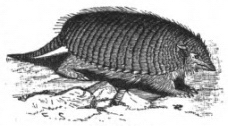foot barricade into the audience, bounded up the nearest aisle to the top of the grandstand, leaped down, and was last seen heading for the jungle. No one was hurt, for everybody gave him plenty of room. Another much-advertised beast that is seldom seen is the tapir, a fat black grass-eater, that looks like a miniature elephant with a very short trunk. Deer are still fairly abundant, pretty little things, not much bigger than a North American jack-rabbit. Centuries ago there were large numbers of warrees, or wild hogs, and of long-tailed, black-and-white monkeys, "the ugliest I ever saw," wrote Captain Dampier, the bucaneer naturalist. But to shoot either of these to-day, a hunter would have to

ARMADILLO.
go deep into the jungle. Perhaps the most curious-looking animal on the Isthmus is the armadillo, "the little armored one," the Spaniards called him, because of the heavy rings of natural plate-mail that protect him against the teeth and claws of his enemies, as do the quills of the Northern porcupine.
Reptiles are well represented on the Isthmus, though snakes are very much scarcer in the Canal Zone than one would naturally suppose. Only a few small boa-constrictors—eight feet long or so—were killed during the building of the Canal, and there is no case of a laborer having been fatally bitten by a poisonous snake, although both the coral-snake and the fer-de-lance are said to be found in Panama. Old stone ruins, that in the North would be swarming with blacksnakes and ad-
